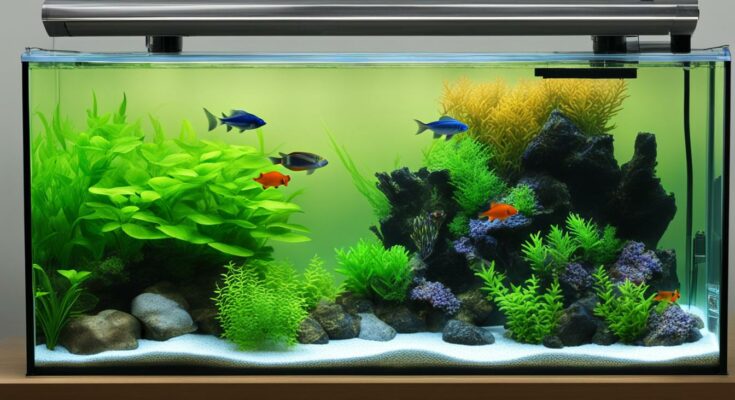Welcome to our expert guide on the proper placement of aquarium heaters. If you’re a fish enthusiast, you understand the importance of maintaining the optimal temperature in your aquarium for the health and well-being of your aquatic pets. In this article, we will explore the best position for aquarium heater placement to ensure even distribution of heat and avoid any temperature fluctuations that could harm your fish. Let’s dive right in!
Key Takeaways:
- Placing the aquarium heater near the maximum water flow ensures quick and even heat distribution throughout the tank.
- For larger tanks, it is recommended to use two heaters placed at opposite ends to maintain a uniform temperature.
- Heat is distributed through conduction, convection, and circulation, so it’s important to place the heater near the filter outflow.
- Proper temperature regulation is crucial for fish metabolism, growth, and reproductive health.
- Improper heater placement can lead to stress, reduced immune system function, and even fish fatalities.
Why Proper Aquarium Heater Placement is Important
Proper aquarium heater placement plays a crucial role in ensuring the comfort and health of the fish in your tank. By placing the heater near the water flow, you can achieve even distribution of heat, preventing hot spots and temperature fluctuations. This is essential for fish metabolism, growth, and reproductive health, as well as overall well-being.
Incorrect heater placement can have a detrimental impact on fish health. Improper temperature regulation can cause stress, weaken the immune system, and even lead to fatalities among fish. By placing the heater in the right location, you create an environment that is less prone to diseases and infections, promoting the longevity and vitality of your aquatic pets.
When considering aquarium heater placement, factors such as tank size, heating capacity, and water circulation should be taken into account. Larger tanks may require multiple heaters placed at opposite ends to maintain a uniform temperature. It is important to avoid obstructing water flow with rocks or decorations and to ensure proper water circulation in the tank. Regular monitoring and adjustments may be necessary to maintain the desired temperature.
Benefits of Proper Heater Placement
“Proper placement of the aquarium heater ensures even distribution of heat, preventing hot spots and temperature fluctuations, which can have a detrimental impact on fish health.”
The benefits of proper heater placement extend beyond just temperature regulation. By maintaining a consistent and suitable temperature, you create an environment where fish can thrive. Proper temperature conditions support their metabolic processes, promote healthy growth and reproduction, and enhance their overall vitality and well-being. By adhering to best practices for aquarium heater placement, you are providing your fish with the optimal conditions they need for a happy and healthy life.
| Key Considerations | Benefits |
|---|---|
| Even distribution of heat | Prevents hot spots and temperature fluctuations |
| Supports fish metabolism | Enhances growth and reproductive health |
| Optimal temperature conditions | Promotes overall fish well-being |
Factors to Consider for Optimal Aquarium Heater Placement
When it comes to placing an aquarium heater, several important factors should be taken into consideration. The right placement can ensure optimal heat distribution and create a comfortable environment for your aquatic pets. Here are some key factors to keep in mind for optimal aquarium heater setup:
1. Tank Size
The size of your tank plays a significant role in determining the placement of your heater. For smaller tanks, a single heater placed near the water flow can generally suffice. However, larger tanks may require multiple heaters strategically positioned at opposite ends to maintain a uniform temperature throughout. It’s important to choose a heater with the appropriate wattage for your tank’s capacity to ensure efficient heating.
2. Heating Capacity
The heating capacity of your heater should align with the size of your tank. It’s recommended to have a heater with a wattage of 5 watts per gallon of water capacity. This will provide sufficient heat to maintain the desired temperature. Consider the specific needs of your aquarium inhabitants and choose a heater that can meet those requirements.
3. Water Flow
The flow of water in your tank is another crucial factor to consider for optimal heater placement. Placing the heater near the outlet or inlet of your filter, or in the path of a powerhead, ensures that the heated water is quickly and evenly distributed throughout the tank. This helps prevent hot spots and temperature fluctuations, providing a more stable and comfortable environment for your fish.
| Factors to Consider | Considerations |
|---|---|
| Tank Size | Choose a heater based on the size of your tank, ensuring efficient heat distribution. |
| Heating Capacity | Select a heater with the appropriate wattage to meet the needs of your aquarium inhabitants. |
| Water Flow | Place the heater near the filter outlet or in the path of a powerhead for even heat distribution. |
By considering these factors when setting up your aquarium heater, you can ensure optimal placement and create a comfortable and healthy environment for your fish and other aquatic inhabitants.
Tips for Proper Aquarium Heater Placement
Proper placement of your aquarium heater is essential for maintaining a healthy and comfortable environment for your fish. Here are some tips and guidelines to ensure optimal heater positioning:
1. Choose the Right Location
Select a location with high water flow, such as near the filter outlet or in the path of a powerhead. This will help distribute heat evenly throughout the tank and prevent the formation of hot spots. Avoid placing the heater near direct sunlight or other heat sources that can affect temperature readings.
2. Optimize Water Circulation
Strategically positioning powerheads or wavemakers can create a uniform flow, which will aid in distributing heated water. This helps maintain a consistent temperature throughout the aquarium and ensures that all areas receive sufficient heat.
3. Use Multiple Thermometers
Utilize multiple thermometers placed in different areas of the tank to monitor temperature variations. This will help identify potential hot spots and ensure that the heater is maintaining the desired temperature. Regular monitoring and adjustment of the heater’s position or thermostat settings may be necessary to maintain a stable and consistent temperature.
| Tip | Description |
|---|---|
| 1 | Choose a location with high water flow. |
| 2 | Optimize water circulation with powerheads or wavemakers. |
| 3 | Use multiple thermometers to monitor temperature variations. |
By following these tips and best practices, you can ensure that your aquarium heater is properly placed, providing optimal temperature conditions for your fish and promoting their overall health and well-being.
Advanced Techniques for Aquarium Heater Placement
When it comes to aquarium heater placement, there are advanced techniques that can be employed to optimize the heating system and provide an ideal environment for your aquatic pets. Strategic positioning of the aquarium heater can ensure efficient heat distribution and prevent hot spots in the tank. By following these innovative heater installation tips, you can take your aquarium setup to the next level.
“Proper heater placement is essential for maintaining a stable temperature in the tank. One advanced technique is to position the heater near the water inlet of the filter. This allows the heated water to be quickly circulated and distributed throughout the tank, ensuring an even temperature. Additionally, using a circulation pump or powerhead can create a flow pattern that helps disperse the heated water effectively.”
Another advanced technique for aquarium heater placement is to create a temperature gradient in the tank. This involves placing the heater at one end of the tank and positioning a powerhead or wavemaker at the other end. The powerhead creates a flow of water that carries the heated water from one end to the other, creating a gradual temperature change in the tank. This technique mimics natural conditions and provides a more stimulating and dynamic environment for your fish.
When implementing advanced heater placement techniques, it is important to closely monitor the temperature in different areas of the tank. Using multiple thermometers can help identify any temperature disparities and ensure that the heater is functioning optimally. Adjustments may need to be made to the heater position or thermostat settings to maintain a consistent and desired temperature throughout the tank.
Factors to Consider for Energy Efficiency in Aquarium Heater Placement
When it comes to placing your aquarium heater, energy efficiency should be a top consideration. Not only can an energy-efficient setup help reduce your environmental impact, but it can also save you money on electricity costs. To achieve energy efficiency, there are a few factors you should take into account.
Calculating Energy Needs for Your Aquarium Heater
To optimize energy consumption, it’s important to calculate the energy needs of your aquarium heater setup. You can do this by multiplying the wattage of your heater by the number of hours it is on each day. For example, if your heater is 100 watts and runs for 8 hours a day, the daily energy consumption would be 800 watt-hours or 0.8 kilowatt-hours (kWh). By comparing the energy consumption of different setups, you can choose the most efficient option for your needs.
“By calculating the energy needs of your aquarium heater setup, you can choose the most efficient option for your needs.”
Reducing Energy Consumption in Heater Setup
There are several strategies you can implement to reduce energy consumption in your aquarium heater setup. First, consider the size of your tank. A smaller tank will require less energy to heat than a larger one. Additionally, insulating your tank with a cover or using a tank heater can help retain heat, reducing the workload on your heater. Finally, using a heater with a thermostat can help regulate the temperature more efficiently, preventing unnecessary energy consumption.
Optimizing Placement for Energy Efficiency
The placement of your aquarium heater can also impact energy efficiency. Placing the heater near the water flow, such as near the filter outlet or in the path of a powerhead, can help distribute heat more effectively throughout the tank. This ensures that the heater doesn’t have to work as hard to maintain a consistent temperature. Additionally, avoid placing the heater near heat sources or direct sunlight, as this can lead to inaccurate temperature readings and increased energy consumption.
| Aquarium Heater Placement Tips for Energy Efficiency | Impact on Energy Consumption |
|---|---|
| Place the heater near the water flow | Efficient heat distribution |
| Avoid placing the heater near heat sources or direct sunlight | Prevents inaccurate temperature readings |
| Insulate your tank with a cover or use a tank heater | Retains heat, reducing workload on the heater |
| Use a heater with a thermostat | Regulates temperature more efficiently |
By considering these factors and implementing energy-saving strategies, you can achieve a more energy-efficient setup for your aquarium heater. Not only will this benefit the environment, but it will also help you create a more sustainable and cost-effective aquarium.
Safety Considerations for Aquarium Heater Placement
When it comes to placing an aquarium heater, safety should be a top priority. By considering a few important factors, you can prevent hazards in the heater setup and avoid temperature fluctuations that could harm your fish. Here are some essential safety considerations to keep in mind:
1. Proper Submersion
It is crucial to ensure that the heater is fully submerged according to the manufacturer’s instructions. Partially submerged heaters can lead to electrical hazards, such as short circuits or electrocution. Make sure the water level remains consistent to avoid exposing the heating element or thermostat, which can cause inaccurate temperature readings and potentially harm your fish.
2. Avoiding Heat Sources
Placing the heater near other heat sources, such as additional heaters or lights, can create temperature inconsistencies and fluctuations. Ensure that the heater is not positioned near direct sunlight, as this can also impact temperature readings. By keeping the heater away from external heat sources, you can maintain a stable and consistent temperature in the aquarium.
3. Regular Maintenance and Monitoring
Regularly check the thermostat and rheostats to ensure they are functioning properly and not exceeding their wattage capacity. Faulty or malfunctioning equipment can lead to overheating or temperature spikes, which can be harmful to your fish. By conducting routine maintenance and monitoring, you can identify any issues early on and take appropriate action.
By taking these safety considerations into account, you can create a secure and stable environment for your aquarium. Remember to always follow the manufacturer’s instructions and consult with experts if needed. Prioritizing safety will help protect your fish and ensure their well-being in the aquarium.
Conclusion
In conclusion, proper placement of an aquarium heater is essential for the well-being of your fish and the overall health of your tank. By placing the heater near the water flow, you can ensure that heat is evenly distributed, preventing hot spots and temperature fluctuations. Consider factors such as tank size, heating capacity, and water circulation to determine the optimal placement for your heater.
Advanced techniques like using timers, rheostats, and thermostats can provide you with greater control over the aquarium environment, allowing you to fine-tune temperature conditions. Additionally, prioritizing energy efficiency and following safety considerations will not only benefit your fish but also help reduce energy consumption and prevent hazards.
By following the guidelines and tips outlined in this article, you can create an optimal environment for your aquarium, promoting the health and happiness of your aquatic pets. Remember, proper heater placement is a key factor in maintaining the comfort and well-being of your fish, ensuring they thrive in their aquatic habitat.
FAQ
Where is the best location for placing an aquarium heater?
The best location for placing an aquarium heater is near the maximum water flow, such as the outlet (or inlet) from the filter or in the stream of a powerhead. This ensures that heated water is quickly and evenly dispersed throughout the tank.
How much wattage should the heater have?
It is recommended to have a heater with a wattage of 5 watts per gallon of water capacity. For larger tanks, it is advisable to use two heaters placed at opposite ends to maintain a uniform temperature and provide a backup in case one heater fails.
How is heat distributed in the aquarium?
Heat is distributed in the aquarium through conduction, convection, and circulation. It is important to place the heater near the filter outflow to prevent overheating the biofilter and to use an air stone under the filter intake to help draw cool water near the bottom of the tank into the circulation current.
What factors should be considered for optimal aquarium heater placement?
When determining the optimal placement for an aquarium heater, several factors should be considered. These include the size of the tank, the heating capacity of the heater, and the flow of water in the tank.
Are there any advanced techniques for aquarium heater placement?
For advanced aquarium hobbyists, there are additional techniques for heater placement that can be implemented. These include utilizing light timers to automate the on/off cycle of various gadgets, such as heaters and lights, and using rheostats and thermostats to regulate and fine-tune the amount of light and heat within the enclosure.
How can energy efficiency be considered in aquarium heater placement?
Energy efficiency is an important consideration in aquarium heater placement. Calculating the energy needs of the setup can help determine the most efficient placement and reduce energy consumption. Using timers, rheostats, and thermostats can further optimize energy usage.
What safety considerations should be kept in mind for aquarium heater placement?
Safety is paramount when placing an aquarium heater. Ensure that the heater is submerged fully or according to the manufacturer’s instructions to prevent electrical hazards. Avoid placing the heater near heat sources, such as heaters or lights, and position the thermostat or sensor away from direct sunlight to avoid temperature fluctuations.




